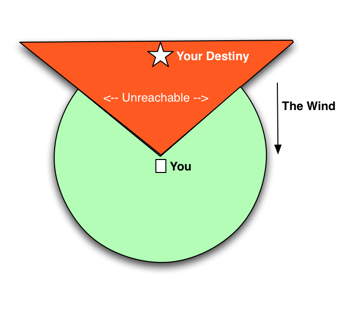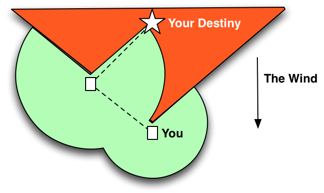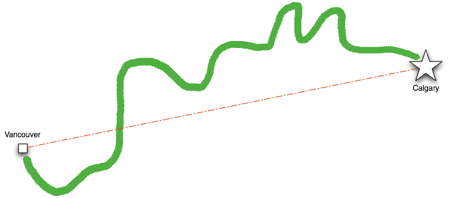Forget The Shortest Path
October 31st, 2006The shortest distance between two points is a straight line. This is one of those darned Euclidian facts of life. Of course, it’s only fact in a paper life. Everywhere else, it’s an exception. In real life for instance, things get in the way.
The shortest path is only useful if it’s both possible and expeditious to follow that route. On paper the shortest path always takes the same amount of work. We drag the stylus against the straight edge. Nothing hinders our progress in two dimensions, except for the possible breakage of pencil lead.
In real life, everything gets in the way. So the shortest path is only useful to the extent that it provides a line of sight. Something we can aim for, even as we twist and turn in ridiculously off-course directions to reach the destination.
Something I’ve been meaning to do for a number of years is to learn how to sail. This year, late in the summer, I finally got started with that endeavor. I joined Boston’s Community Boating, Inc., where kids can learn to sail for a mere US$1, and adults can buy a year’s membership for less than US$200. Learning to sail must be a lifelong process, and I’m just a newbie. But even after a week on the water, I was impressed by one of the fundamental facts of sailing. You can sail in almost any direction except for straight into the wind. I find it amazing that you can actually harness the power of the wind blowing straight at you, and turn it into energy that propels your boat sideways, or even sort of towards it!. The bad news, of course, is you can’t always sail straight towards your destination. If you want to travel towards the wind, you’re out of luck:

When you’re sitting out in the middle of the Charles River collecting sailing experience and a sunburn, this is a pretty profound lesson. The shortest distance between two points is not a straight line, when a straight line is impossible!
Fortunately for sailors, there’s an easy workaround. It only takes a little bit longer than a straight line, and it has the major advantage of being possible. You simply achieve your destiny by traveling away from it until it is achievable by a straight line:

The cool lesson from this fact of sailing life is that by merely changing your position in any direction you may alter the viability of your goal from the impossible to the possible. If this little observation were only true in sailing, it would hardly be worth mentioning in my blog. But some version of this “wide angle shortcut” applies to almost every obstacle you’re liable to encounter in life. In fact, if you think about the ways we reach our various destinations, it’s almost never by straight line. We’re accustomed to twisting and turning, yet when we step back and aim for a goal, we’re foolishly obsessed with striving for the shortest path!
Let’s say you’re walking through the woods and you come upon a steep incline. The best thing to do might be to climb straight up, but in all likelihood you’d be better off going around. Going up and over might even be impossible. This concept becomes truer and truer the more limitations there are on your mobility. Take railroads, for instance. Railroad track must be set on fairly level ground. Trains can’t just jump over a mountain. So when the early railroad pioneers sought to lay track across the American continent, they had to compromise. Big time. In fact, choosing to take the longer path was an act of brilliance. A good example of this is the Rocky Mountaineer Railroad, which connects Calgary and Vancouver. Let’s see. How can I represent this without violating some copyright. I guess I’ll do a crude representation:

The red line represents the shortest path, but the green line represents the shortest possible path! The path the railroad had to actually take to stand a chance of reaching its destination. You’ve got to contend with mountains, my friend. So the next time you face a formidable problem, when something stands in your way and pushes against you with all its might, consider taking a different route. An oblique route. It’s how the greatest thinkers in history have reached their destinations, so it’s probably good enough for you, too.


October 31st, 2006 at 9:45 pm
You’re forgetting great circle paths btw. So what looks like the shortest path on a map is rather longer than the shortest possible path due the curvature of the earth and the projection of the map you’re using.
Must be halloween right?
October 31st, 2006 at 10:10 pm
Of course, in some cases, instead of going around the mountain, they took a million pounds of dynamite and just blasted through it. It’s using a brute force approach to reinforce the straight line thinking. Not sure what the point of me bringing this up is but maybe it’s about being able to know when to blast through and when to go around. Or maybe the point is that the shortest path cannot be ascertained by only looking at one dimension of the problem. Most likely, the real point is that I should shut up now and do something more productive than rambling on your blog.
October 31st, 2006 at 10:29 pm
When to blast through and when to go around is often dictated by resources.
In Europe, in the 19th century, labor was cheap while materials and land were expensive, so labor-intensive methods like tunneling through the Alps made sense. In America, it was the other way around, and railroad companies preferred to meander around the mountains laying miles of extra track instead of punching labor-intensive holes.
If you’re enjoying sailing, I cannot recommend the Master And Commander books highly enough.
October 31st, 2006 at 11:52 pm
I just got a mental image of Daniel wearing an orange lifejacket, strapped to the mast of a sailboat, gleefully crying out “Look! I sail!”
Just kidding, Daniel. What About Bob references aside, I love sailing metaphors. Thanks for posting the insight.
November 1st, 2006 at 12:10 am
Being a total landlubber I’d never thought about the physics of sailing before, thanks for the neat educational infographics (and subsequent inspirational metaphor) :)
November 1st, 2006 at 12:19 am
That first diagram is almost a Feynman Diagram.
November 1st, 2006 at 2:40 am
You forgot to mention waiting as a solution. There is no need to tack, wait for things to change (in this case the wind) and the shortest course is the one you would have drawn on paper. Patience is a virtue. Good choice on the starboard tack, it means you have the right of way for the first leg of the manoeuvre giving you an advantage — you were born an innate sailor. Come to Spain next year and get hooked for life.
November 1st, 2006 at 3:31 am
You forgot to mention waiting as a solution.
Daniel’s approach covers that if you think in four dimenions.
November 1st, 2006 at 12:01 pm
“You can sail in almost any direction except for straight into the wind.” — I learned this playing Wind Waker on the GameCube. Though, sailing was pretty easy considering you could play a song and a adjust the wind to fit your needs.
November 1st, 2006 at 1:30 pm
My experience is limited, but just to speak more on the sailing part of the analogy, tacking can be tedious. Tacking involves a lot of zig-zagging, making a bunch of small indirect steps towards the destination. I find it to be ingenious but it can be a pain having to dodge the boom as you come about constantly. You could just kick in the motor if you are feeling lazy but I feel it destroys the whole mood; the main point of sailing for me being able to travel with only the sound of the water and wind.
Waiting is not always a good option or can make things worse in the end. If low-tide is approaching it can cut off certain routes as rocks that were sufficiently underwater for you to clear before are now closer to the surface. Plus, sometimes you just want to get home in time to cook some lobster.
November 1st, 2006 at 1:43 pm
I have yet to sail in a boat that has a motor. Probably because I’m basically learning on toy boats. But I agree I wouldn’t want to use a motor except for special circumstances. It seems like all the thrill of it for me is in harnessing the wind and getting it to do something “impossible” like moving me towards it.
November 1st, 2006 at 3:11 pm
There is nothing better than blasting along on a port tack with the mainsheet balancing the tiller, and the jib holding the bow straight whilst you sit with your feet dangling over the windward side in the brilliant sunshine.
Or sailing close to the wind in a Gale Force 6 with full sails up, and having to brace yourself against the lee cockpit coaming to try and get the lee rail under as much as possible, whilst hoping at the same time that the keep doesn’t decide to drop off at that point.
Either way, its all good fun. Tacking upwind in a breeze in a river that is bridged by trees is not however (3 hours to go half a mile! – We couldn’t be bothered to Quant.)
I’m sailing a Topper Magno next week (big dinghy) for my birthday present to myself, so that should be fun, and reading this makes me realise how much I miss sailing.
November 1st, 2006 at 3:32 pm
The first diagram is also almost an IDIC symbol.
November 3rd, 2006 at 1:24 pm
Interesting analysis. All this reminds of the value of curvilinear thinking as opposed to the habit to think in terms of rectilinear space. So much becomes possible when you see the world in terms of curved space instead of straight lines.
If you like philosophy, you might enjoy reading Gilles Deleuze’s book The Fold. I think it touches on similar themes and thoughts.
November 6th, 2006 at 5:34 pm
Very interesting. I’m not a sailor, but I work a good bit with the shortest path (graph theory). Good read.
April 27th, 2011 at 4:57 am
A leader always knows when to adjust the sails…